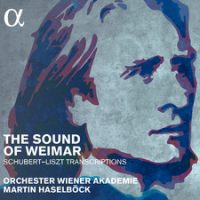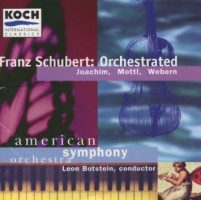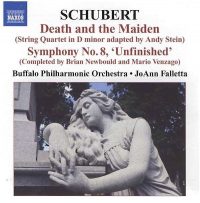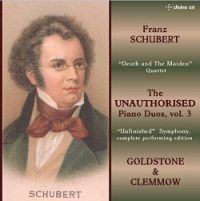(Dis)Arrangements 8: More Schubert
|
Grant Chu Covell [May 2016.]
“The Sound of Weimar.” Franz SCHUBERT: Reitermarsch from Deux Marches Caractéristiques, Op. 121, No. 1, D. 886 (1826?; arr. Franz LISZT, 1859-60); Trauermarsch from Six Grandes Marches, Op. 40, No. 5, D. 819 (1824?; arr. LISZT, 1859-60); Ungarischer Marsch from Divertissement à la Hongroise, Op. 54, D. 818 (1824; arr. LISZT, 1859-60); Fantasy in C Major, Op. 15, D. 760, “Wanderer-Fantasie” (1822; arr. LISZT, S. 366, 1851-52). Franz LISZT: Zwei Traueroden, S. 112 (1860-66); Vexilla Regis Prodeunt – Kreuzeshymne, S. 185 (1864). Gottlieb Wallisch (pno), Orchester Wiener Akademie, Martin Haselböck (cond.). Alpha 471 (1 CD) (https://www.outhere-music.com/en/labels/alpha). Liszt’s Schubert transcriptions demonstrate two philosophies. He orchestrated four Schubert Marches and three are here. Among them Reitermarsch captures the liveliness of the original four-hand piano work and is cast as a showpiece, and Trauermarsch suggests that Mahler isn’t that distant. These occasional pieces are literal transcriptions. On the other hand, Liszt transformed the Wanderer Fantasy. Schubert left no concertos, but we do have Liszt’s overstuffed quasi-symphonic Fantasy for piano and orchestra. Presented in four sections, Liszt’s piano is brilliant with extra notes, ricochet attacks to delineate the piano soloist, and repetitions to ensure everything is heard and to create a more formal concerto or symphonic structure. Wallisch plays an 1851 J.B. Streicher which pivots Liszt’s grand Romantic nature against the antique instrument. Plenty of modern renditions cater more towards the virtuosic Liszt of the “Triangle” Piano Concerto, whereas these period instruments step backwards more gratifyingly without being nostalgic. The Orchester Wiener Akademie is working their way through all of Liszt’s orchestral music. Here they offer two late Funeral Odes, opulent following Schubert’s crisp corners, but nonetheless poignant. Schubert approaches death head-on, like an expected visitor, whereas Liszt pouts, full of regrets. This is the first performance of the sober Vexilla Regis Prodeunt.
“Franz Schubert: Orchestrated.” Franz SCHUBERT: Sonata in C major, D. 812, “Grand Duo” (1824; arr. Joseph JOACHIM, 1855); Fantasia in F minor, D. 940 (1828; arr. Felix MOTTL, 1897); Six German Dances, D. 820 (1824; arr. Anton WEBERN, 1931). American Symphony Orchestra, Leon Botstein (cond.). Koch 3-7307-2 (1 CD). Schubert becomes boring and tedious under Joachim’s stifling orchestration. Perhaps he thought the secret to 19th-century orchestration was to overdress every phrase and chord with doubling and tripling. Bloated and dull, it’s a perfect example of what not to do. (Despite best intentions another recording also bored to tears.) In contrast, Mottl and Webern maintain lightness through solos and interplay between instrumental choirs. Their Classical demeanor more effectively captures Schubert’s piano style. The historic recording of Webern conducting his own arrangement from December 1932 can still be found (e.g., tacked onto Columbia’s recent 67-disc Boulez set 301333). It’s a mesmerizing remnant of an extinguished age. This modern recording does the brief, seven minutes justice. Unlike the klangfarbenmelodie of his more famous Bach Ricercare orchestration, Webern’s Schubert is reasonably conventional, melodies staying put with instruments and cadences lightly emphasized.
Franz SCHUBERT: String Quartet in D minor, “Death and the Maiden,” D. 810 (1824; arr. Andy STEIN); Symphony No. 8 in B minor, “Unfinished,” D. 759 (1823; compl. Brian NEWBOULD; ed. Mario VENZAGO). Buffalo Philharmonic Orchestra, JoAnn Falletta (cond.). Naxos 8.572051 (1 CD) (http://www.naxos.com/). Stein’s Death and the Maiden steps beyond Mahler’s more familiar string orchestra with contrabass arrangement adding winds, horns, trumpets and timpani. Themes appear in alternating choirs smartly doubled and supported, in a palette which nudges Schubert towards Schumann and Mendelssohn and even close to Mahler’s orchestral style. The second movement becomes a varied theme and variations, whereas the concluding Scherzo and Rondo are more conventionally drawn. The only qualm with this release is that the Buffalo strings can become brutish when the volume is turned up. A more delicate touch as demonstrated in the Scherzo would please more. Newbould’s Eighth completion is hardly news: After studying the Scherzo drafts, he contributed an orchestration and one of the Trio themes. If provisional, it’s also somewhat perfunctory. Also well accepted is that the Rosamunde Entr’acte matches No. 8 in key and style. Long exposure to the first two movements leads us to expect greater invention and emotional depth in these last two less convincing movements.
“The Unauthorized Piano Duos, Vol. 3.” Franz SCHUBERT: String Quartet in D minor, “Death and the Maiden,” D. 810 (1824; arr. Robert FRANZ, 1878); Symphony No. 8 in B minor, “Unfinished,” D. 759 (1823; arr. Anselm HÜTTENBRENNER, 1853; compl. and trans. Anthony GOLDSTONE, 2015; Entr’acte from Rosamunde, D. 797, 1823, trans. Friedrich HERMANN, ed. GOLDSTONE, 2015). Anthony Goldstone, Caroline Clemmow (pno). Divine Art DDA 25125 (1 CD) (http://www.divineartrecords.com/). Franz created a four-hand piano version of the Schubert quartet that is quite idiomatic, losing nothing of the original quartet’s charm and potency, here executed with panache. The quartet convinces completely in this guise as a four-hand piano sonata. We can easily imagine Schubert working through chord progressions and testing out accompaniments at the keyboard. In contrast, the Eighth doesn’t translate well to the piano. Perhaps Schubert attempted this orchestral effort away from his instrument, in a conscious attempt to shed some of his pianistic habits. Goldstone’s Scherzo completion is the most convincing keyboard movement, more effective than in its orchestral guise simply because the piano’s attack prevents awkward held chords. Like the first two movements, the four-hand Rosamunde Entr’acte is awkward and could have taken cues from the F-minor Fantasia or C-major Marches and had more Alberti bass or tremolo effects.
A Stein, F Hermann, Franz, Goldstone, Hüttenbrenner, Joachim, Liszt, Mottl, Newbould, Schubert, Venzago, Webern
[More (Dis)Arrangements, Grant Chu Covell]
[More
A Stein, F Hermann, Franz, Goldstone, Hüttenbrenner, Joachim, Liszt, Mottl, Newbould, Schubert, Venzago, Webern]
[Previous Article:
Used Bin Troll Tweets Q.]
[Next Article:
Piano Factory 16. / (Dis)Arrangements 9: Liszt and Wagner]
|



